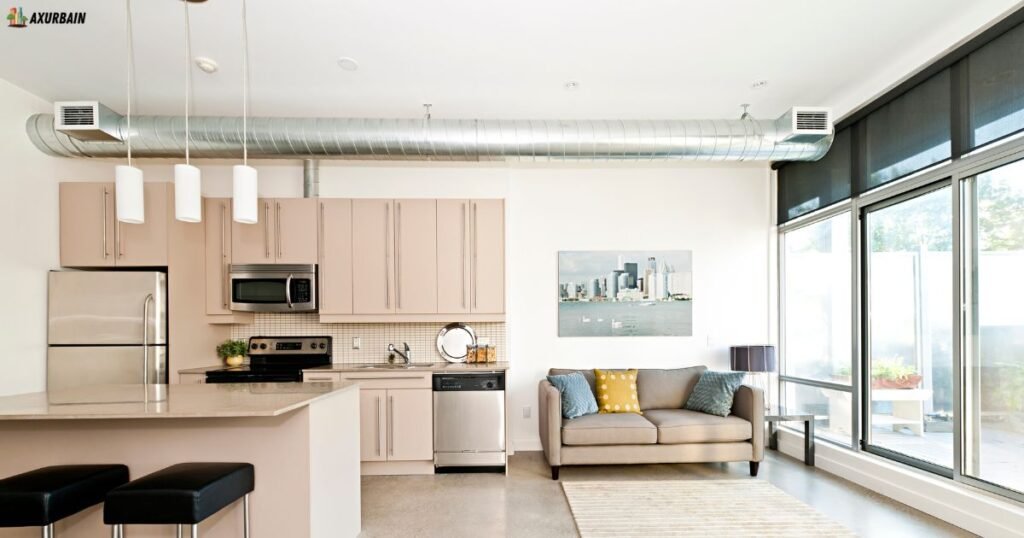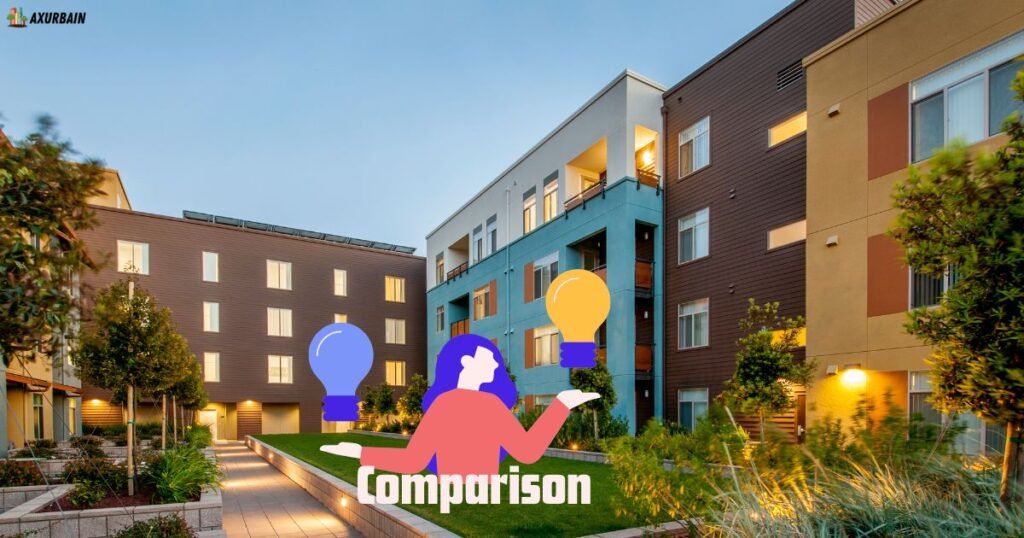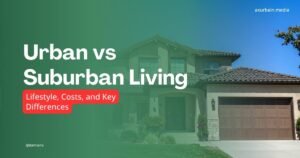Nowadays, buying a home is not a simple process; it’s complicated because there are numerous options: single-family houses, condos, townhomes, and something called Planned Unit Developments (PUDs).
Two of the most commonly confused choices in the real estate landscape are PUDs and condos. Understanding these differences is crucial if you’re buying your first home and seeking a low-maintenance lifestyle, or if you’re investing in real estate.
This guide will walk you through how ownership, amenities, legal rules, and day-to-day living compare between a PUD and a condo so you can make the choice that truly fits your life.
Table of Contents
ToggleWhat is a Planned Urban Development (PUD)?
Definition & Overview
PUD is a type of neighborhood or real estate community where you own both your house and the land it sits on, while also sharing access to common spaces like parks, pools, or clubhouses.
Think of it as a mix of:
- Residential areas → homes, townhouses, or apartments.
- Commercial spots → small shops, cafes, or offices.
- Recreational spaces → parks, walking trails, pools, or playgrounds.
What makes a PUD unique is that it’s not just houses sitting on random lots. The whole community is planned out from the start to bring convenience and lifestyle together. For example, you might be able to grab a coffee at the corner café, walk your dog in the neighborhood park, and then head back to your home all inside the same development.
Most PUDs are managed by a Homeowners Association (HOA). The HOA sets rules for the community, maintains the shared areas, and ensures the neighborhood looks and functions as designed.
Legal & Ownership Structure
One of the biggest things that makes a Planned Urban Development (PUD) different is how ownership works.
- In a PUD, you own both your home and the land underneath it. That means the house, the yard, the driveway, it’s all yours, just like in a regular single-family neighborhood.
- At the same time, there are shared spaces within the community, such as parks, pools, or private roads. These don’t belong to one person; they belong to everyone in the neighborhood.
This is where the Homeowners Association (HOA) comes in. The HOA is responsible for maintaining these common areas in a clean, safe, and well-maintained condition. Your monthly HOA fee helps cover the costs of this upkeep.
What is a Condominium (Condo)?

Definition & Overview
A Condominium (Condo) is a type of housing where you own just your individual unit inside a larger building or community. Picture it like an apartment you buy, rather than rent.
- You own the interior space of your condo—the walls, floors, and ceilings that make up your home.
- Everything outside your unit (hallways, elevators, lobbies, the roof, parking garage, and even the land the building sits on) is shared property, owned together by all condo owners.
Condos can look very different depending on where you live:
- In big cities, they’re often tall high-rise buildings.
- In suburban areas, they may resemble townhouses in a gated community.
Legal & Ownership Structure
When you buy a condo, your legal ownership is limited to the inside of your unit—the walls, floors, and ceilings that define your private space. You do not own the land beneath the building or the exterior structure.
Everything outside your front door is considered a common element, which is jointly owned by all the condo owners in the building. These shared elements include:
- Hallways and elevators
- The roof and exterior walls
- Lobbies and recreational areas
- Parking lots or garages
- The land the building sits on
A Condo Association (or HOA) manages these common areas. They collect monthly fees from every owner to cover expenses such as building repairs, landscaping, security, insurance, and shared amenities.
Planned Urban Development vs Condo: Detailed Comparison

Ownership
Ownership is the biggest difference between a PUD and a condo.
- Planned Urban Development (PUD): You own both your home and the land beneath it. This usually includes your front yard, backyard, and driveway—just like a single-family house.
- Condo: You own only the inside of your unit. The land, roof, walls, and all common areas are shared among other condo owners.
👉 Think of it this way:
- Buying in a PUD is like buying the entire “box” (your house plus the land it sits on).
- Buying a condo is like buying what’s inside the “box” (your unit), while the box itself belongs to everyone.
Community & Density
A Planned Urban Development (PUD) often feels like a suburban neighborhood. Homes are typically spaced out, featuring yards, private driveways, and more space between neighbors. The community is designed to feel open and residential, giving you the sense of living in a traditional subdivision, but with shared amenities nearby.
A condominium, on the other hand, is built for higher-density living. Units are stacked or closely connected, and residents share walls, floors, and ceilings. This setup is common in cities where space is limited, which is why condos often have an urban feel. Living in a condo means being part of a busier, more compact community where you’re surrounded by neighbors and the pace of life tends to be more active.
Amenities & Services
Both PUDs and condos often come with amenities like pools, gyms, or clubhouses, but the way they are offered can feel different. In a PUD, amenities are shared across a wider community, so you might walk to a neighborhood pool or community park.
Condominiums often focus on building-specific services, meaning your gym, lobby, or concierge is exclusively for the residents of that building. In short, a condo’s perks tend to be closer and more immediate, while a PUD’s amenities feel like part of the larger neighborhood.
HOA Fees & Responsibilities
Both PUDs and condos have Homeowners Associations (HOAs), but the fees and responsibilities vary. In a PUD, HOA fees are usually lower because they mainly cover common spaces like parks or private roads.
In a condo, fees are higher because they cover building maintenance, insurance, and sometimes even utilities. Essentially, condo fees are like paying for a “full-service” living experience, while PUD fees are more about shared neighborhood upkeep.
Maintenance & Repairs
In a PUD, you are responsible for the exterior of your home and the land around it. This means mowing the lawn, fixing the driveway, and maintaining your roof.
In a condo, the association handles most exterior or structural maintenance, leaving you responsible only for the interior of your unit. It’s a trade-off: more control in a PUD versus less work in a condo.
Insurance Differences
Insurance works differently, too. PUD owners get homeowners’ insurance, which covers both the building and the land it sits on. Condo owners buy condo insurance, sometimes called “walls-in” coverage, which protects only the interior of the unit. The condo association usually insures the building’s exterior and shared areas.
Financing & Mortgage Considerations
When it comes to mortgages, lenders often treat PUDs like single-family homes, making financing simpler.
Condos can face stricter rules, especially if the building must meet Fannie Mae or FHA approval standards. This is something buyers should check early, as condo financing can be slightly more complicated.
Lifestyle & Community Feel
The lifestyle of a PUD feels suburban and neighborhood-oriented.
You might know your neighbors by name, enjoy more open spaces, and live at a slower, quieter pace. Condos, in contrast, offer an urban, apartment-style lifestyle. You’re closer to city life, shops, and public transit, with a busier environment and a denser community feel.
For more on urban lifestyle, check out Advantages and Disadvantages of Living in Urban Areas.
We have discussed the differences in detail. Now it’s time to decide whether a condo or PUD is best for you.
Take a look at the pros and cons of each one.
Pros & Cons of Planned Urban Development (PUD)
PUDs offer various advantages, such as owning your land and enjoying more privacy, but they also come with responsibilities, including maintenance and adherence to HOA rules.
Below is a table to help you understand it better.
| Pros | Cons |
| Own your land | More maintenance required |
| Lower HOA fees | HOA rules still apply |
| More privacy & space | Higher insurance costs |
| Stable resale value | Less flexibility in changes |
| Access to community amenities | Monthly fees still apply |
| Family-friendly environment | Responsibility for landscaping |
Pros & Cons of Condominiums (Condo)
Buying a condo comes with a different set of advantages and drawbacks. The table below helps you quickly see what’s good and what’s challenging about condo living.
| Pros | Cons |
| Lower entry cost | High HOA fees |
| Minimal maintenance | Limited control (shared walls) |
| Access to luxury amenities | Financing can be tricky |
| Ideal for city living | Resale may be slower |
| Close to shops & transit | Rules and restrictions apply |
| Social, community-focused | Less privacy than a house |
How to Choose Between a PUD and Condo?
According to my perspective, ask yourself:
“Do I want full control of my space, or do I value convenience and low upkeep?”
Your answer usually points clearly toward a PUD or a condo. Every person has their own taste and mindset. Below are the factors that can influence your decision when investing in real estate.
Factors to Consider
Budget and financing:
In the world of sales and purchases, the budget is the ultimate factor that depends on.
PUDs require a larger upfront investment since you’re buying land and a home, while condos usually cost less initially.
Keep in mind that condo mortgages may have stricter requirements, depending on the building’s approval and association rules.
Desired lifestyle (suburban vs urban):
This is the point where personality traits come into play. Get to know yourself, your taste, and your needs.
If you want space, yards, and a quieter neighborhood vibe, a PUD may be the better fit. If you prefer being in the heart of the city, close to shops, restaurants, and public transport, a condo makes more sense.
Maintenance preference:
A house is not about building at once; renovation and maintenance are the key factors.
PUD living means you’re responsible for your home’s exterior, yard, and driveway, while condos offer a lower-maintenance lifestyle since the association handles the building and shared areas.
Although you need to maintain it by spending less or more.
Long-term investment goals:
Your house is your big investment in real estate. Whether it’s low or high doesn’t matter. You are spending your money to buy it.
PUDs often offer more stable resale value, especially in growing neighborhoods, whereas condos can appreciate well in prime urban areas but may be affected by factors such as supply and demand, as well as HOA rules.
One of our valued companions, Rich Dallas, has extensive experience in real estate and home services. He has a great YouTube video comparing PUDs and Condos.
Take a look at the expert opinion.
FAQs About Planned Urban Development vs Condo
Is a PUD the same as a condo?
No. In a PUD, you own both the home and the land, whereas in a condo, you only own the interior of your unit and share the common areas with other residents.
Do PUDs have HOA fees like condos?
Yes, but PUD fees are usually lower because they mainly cover shared neighborhood spaces. Condo fees are higher and cover building upkeep, insurance, and sometimes utilities.
Which has better resale value?
PUDs often have more stable resale value because you own the land, but condos can appreciate well in high-demand urban areas.
Which is easier to finance: a condo or a PUD?
PUDs are typically easier to finance, as lenders treat them similarly to single-family homes. Condos may have stricter mortgage rules, depending on the building’s approval and HOA.
Can a condo be part of a PUD?
Yes, some PUDs include condo-style buildings within the larger community. In that case, you’d own the interior of your unit but still share the neighborhood amenities.
Who handles repairs and maintenance?
In a PUD, you handle your home’s exterior and land, while the HOA maintains common areas. In a condo, the association takes care of the building’s exterior, and you’re responsible only for the interior of your unit.




